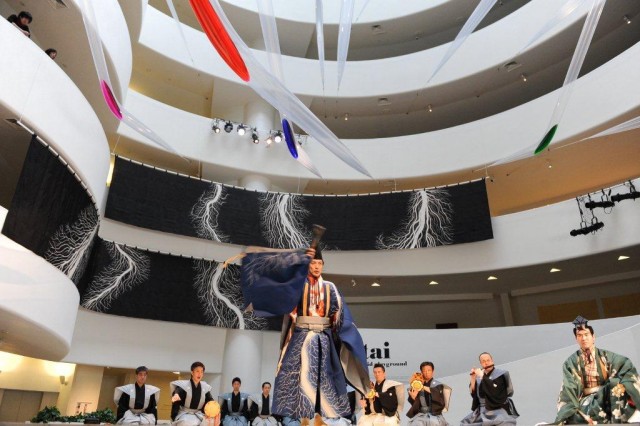Solomon R. Guggenheim Museum
1071 Fifth Ave. at 89th St.
March 28-29, $30-$50
212-423-3587
www.guggenheim.org
In conjunction with the major Guggenheim exhibition “Gutai: Splendid Playground,” which continues through May 8, the museum is teaming up with Japan Society to present the North American premiere of Sanbaso, divine dance, taking place in the rotunda of the Frank Lloyd Wright building March 28 at 2:00 and 8:00 and March 29 at 8:00. The ancient celebratory ritual dance will feature Kyogen actor Mansai Nomura (Onmyoji, Ran) as the title character, joined by five noh musicians and three noh chanters, with the set and costumes designed by Japanese artist Hiroshi Sugimoto based on his recent “Lightning Fields” series of photographs. “It is believed that the roots of Sanbaso lie in the myth of Amaterasu-omikami, the goddess of the sun, who hid in the heavenly rock cave Ama-no-Iwato,” Sugimoto explained in a statement. “This performance expresses how the gods descend to earth and is regarded as the most important performance piece among all the Shinto rituals. . . . The audience of this performance will witness the gods’ presence even in these jaded modern times.” This special program, a tribute to Gutai avant-garde artist Shiraga Kazuo’s Ultramodern Sanbasō, which opened the seminal “Gutai Art on Stage” presentation in 1957, is sold out, but there will be a standby line, with each person allowed to buy one ticket if any become available. In addition, on March 26, Japan Society will host a screening of Yuko Nakamura’s 2012 documentary Memories of Origin — Hiroshi Sugimoto, which follows Sugimoto around the world and includes appearances by architect Tadao Ando, artist Lee Ufan, critic and curator Akira Asada, and actor Mansai Nomura; Sugimoto will introduce the film and participate in a Q&A afterward.

Striking production of SANBASO, DIVINE DANCE lights up the Guggenheim (photo by Enid Alvarez; © 2013 Solomon R. Guggenheim Foundation, New York)
Update: Slow and steady, performed with split-second timing, Sanbaso, divine dance is a striking piece, a highly stylized, precisely choreographed combination of music, vocalization, movement, architecture, and design, beautifully tailored to its surroundings in the Guggenheim rotunda. The mesmerizing performance begins with a noh music medley featuring drums and flute, a traditional sonic introduction that sets the mood for what follows. After the trio of musicians departs, the full cast enters, with Kazunori Takano as Senzai, Haruo Tsukizaki as Koken, and kyogen star Mansai Nomura as the title character, along with a slightly larger group of musicians and vocalists. They all proceed slowly down the spiral from the Guggenheim’s second floor, emerging from behind one of Hiroshi Sugimoto’s lightning-themed curtains and winding their way to the bare stage, which stands about three feet off the ground. As the musicians play — the earlier trio of Rokurobyoe Fujita on fue (flute), Atsushi Ueda on ko-tsuzumi (small hand drum), and Keinosuke Okura on o-tsuzumi (large hand drum) is joined by Yotaro Uzawa on ko-tsuzumi (lead hand drum), Kensaku Araki on waki-tsuzumi (second small hand drum), and a ji-utai (chorus) of Ren Naito, Hiroharu Fukata, and Shuichi Nakamura — a ritual takes place in which the senzai is presented with gold hand chimes, known as suzu, from a box held by the koken. Soon Sanbaso approaches the koken and is given a small, dark mask of an old man’s face that he puts on, then starts taking loud steps and shaking the chimes in unison with the drummers. Flashing his lightning-patterned blue robe designed by Sugimoto, he stops, jerks his head, then lifts and brings down a heavy foot, creating an echo that reverberates throughout the Guggenheim. Nomura is also wearing a tall, dark hat — similar to the one he wore in the two fantastical Onymoji films — that reflects light and the late Motonaga Sadamasa’s water tubes, which arc across the museum, in such a way that it looks like bolts of lightning are streaking down it. At times, Nomura’s foot stomps are like thunder, matching Rie Ono’s lighting that makes the bolts on Sugimoto’s curtains come alive, as if a storm has suddenly arrived. Having honored the gods, Sanbaso returns the mask and chimes to the koken, and the company prepares for the finale, after which they go back up the winding Guggenheim ramp and disappear behind the lightning curtains. It’s nearly impossible to take your eyes off Nomura, who inhabits his role like it’s part of his soul. He even adds a final flourish as he accepts the accolades of the delighted audience, which on Thursday night included Sugimoto as well as Cai Guo-Qiang, whose stunning “I Want to Believe” exhibition filled the Guggenheim five years ago.